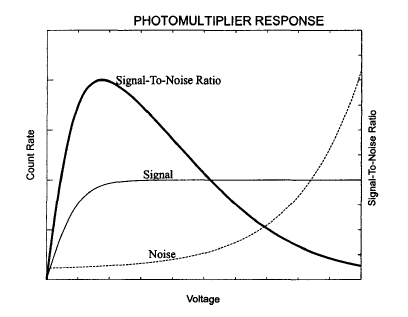The muon lifetime experiment
PART IV: Configuration
High Voltage for PMTs
A high voltage of 2000 V was selected in our case.

[Ref] Using an electron source, find high voltage that maximizes S/N. There is a not a nice plateau as in the Geiger experiment, because one has a wide range of pulse heights. However the operating point is not that critical. Look for a change in the slope of a graph of counts vs. threshold, or log(counts) vs. threshold.
Discriminator Levels
With BIG discriminator the decay rate λdec is aproximately 0.01/sec. The coincidence rate with MINOS scintillator λμ is 1/sec. Discriminator output rate λdisc was selected to 10/s with discriminator level in 4.5.
These values almost eliminate the background (<10%, see demonstration). The histogram should fit to a single exponential.
[Ref] Use an oscilloscope to look at signals out of the PMT and determine the signal size for the electronic noise, a muon passing through the scintillator and an electron decaying after a muon has been stopped in the detector. The last will be the hardest to find. The signal of the decay product electron will occur on average about 2 μsec after the muon stops. Once you have the basic idea of what the signals look like, use the output of the discriminator to trigger the oscilloscope. Lower the discriminator level until the scope triggers all of the time (you should be triggering on the electronic noise). Increase the discriminator level until you no longer see the electronic noise and you see both muons and the occasional electron from muon decay on the scope. Note that stopping muons and stopping electrons will have a higher signal than muons that simply pass through the apparatus.
